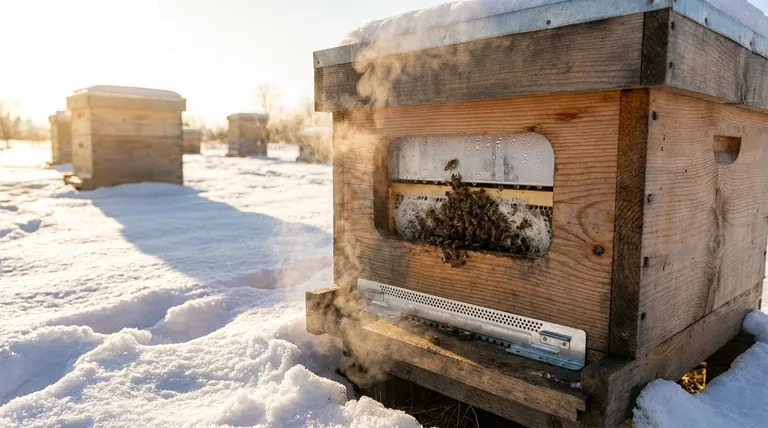Using an entrance reducer on a warm winter day can create a dangerous internal environment for your honey bee colony. The restricted airflow can lead to severe overheating, which in turn causes excessive moisture buildup from condensation. This high-humidity environment is a perfect breeding ground for mold and can be lethal to the colony.
An entrance reducer is a tool of balance. While essential for defense and retaining heat in deep cold, it becomes a liability during unseasonable warmth by trapping the very heat and moisture the colony needs to expel, risking the entire hive's survival.

The Core Problem: Trapped Heat and Moisture
A beehive in winter is a living, breathing system that actively generates heat and moisture. Understanding this internal dynamic is key to understanding the danger of a blocked entrance.
How Bees Generate Heat
In cold weather, bees form a tight winter cluster. They generate heat by shivering their flight muscles, consuming honey as fuel. This process allows them to keep the center of the cluster at a stable, warm temperature, even when it is freezing outside.
The Reducer's Role in Overheating
An entrance reducer helps contain this precious heat during consistently cold periods. However, on a surprisingly warm winter day, the sun can heat the hive externally while the bees continue to produce heat internally. With a small, reduced entrance, this combined heat has no way to escape, causing the hive's internal temperature to skyrocket.
The Moisture Cascade
Bee respiration and the process of metabolizing honey both release significant amounts of warm, moist air. In a well-ventilated hive, this moisture harmlessly exits. In an overheated hive with a reduced entrance, this water vapor rises, hits the cold inner cover or hive walls, and condenses into liquid water.
The Consequences of Poor Ventilation
What begins as a ventilation problem quickly cascades into a series of life-threatening issues for the wintering colony.
Lethal Condensation
The condensed water droplets can drip back down directly onto the winter cluster. Wet bees are dead bees. A cold shower, even inside the hive, will chill them to the point where they cannot move, eat, or rejoin the cluster, leading to their death.
Mold and Disease
A warm, damp, and stagnant environment is the ideal breeding ground for mold and other pathogens. Mold can quickly grow over combs of stored honey and pollen, spoiling the colony's vital winter food supply and potentially sickening the bees.
Unnecessary Stress and Energy Waste
An overheating hive forces the bees to break their efficient winter cluster. They must expend critical energy reserves trying to fan the hive and reduce the temperature, wasting the very fuel they need to survive until spring.
Understanding the Trade-offs
Entrance reducers are a standard piece of beekeeping equipment for a reason. The danger lies not in the tool itself, but in using it without regard for changing conditions.
The Primary Benefit: Defense
The most important function of a reducer is to shrink the hive entrance to a size the colony can easily defend. This is critical for protecting a weaker winter colony from pests like mice seeking a warm nest and from robbing bees from stronger nearby hives.
The Cold Weather Advantage
In consistently freezing weather, a smaller opening reduces the volume of cold air entering the hive. This allows the colony to maintain its cluster temperature with less effort and lower honey consumption.
The "Warm Day" Trap
The trade-off becomes a trap when the weather fluctuates. A reducer set for a 10°F (-12°C) day becomes a dangerous liability on a 50°F (10°C) day. The hardware that protected the colony yesterday can suffocate it today.
Making the Right Choice for Your Goal
Properly managing your hive entrance is about active management, not a "set it and forget it" approach. Your strategy should adapt to your climate and primary concerns.
- If your climate has frequent winter thaws: You must be prepared to adjust the reducer to a larger opening or ensure excellent top ventilation to allow heat and moisture to escape.
- If your primary concern is mice: Use the reducer's smallest opening to exclude them, but you absolutely must compensate with an upper entrance or a quilt box to provide a chimney for moisture to exit.
- If your goal is to minimize all colony stress: The best approach is to balance entrance reduction with a dedicated top ventilation system. This provides defense at the bottom while ensuring a healthy, dry environment inside.
Ultimately, successful overwintering depends on understanding that a beehive must be able to breathe.
Summary Table:
| Problem | Consequence |
|---|---|
| Trapped Heat | Overheating, energy waste, broken winter cluster |
| Moisture Buildup | Lethal condensation dripping on bees, mold growth on food stores |
| Poor Ventilation | Stagnant air, increased risk of disease and pathogen growth |
Ensure your apiary thrives through winter's challenges. Proper hive management is key to preventing moisture-related losses. HONESTBEE supplies commercial apiaries and beekeeping equipment distributors with the durable, high-quality supplies needed for successful overwintering. From ventilation solutions to essential hardware, we support your operation's health and productivity. Contact HONESTBEE today to discuss your wholesale needs and protect your colonies.
Visual Guide

Related Products
- Beehive Entrance Reducer Guardian Metal Hive Entrance for Bees
- Multi-Functional Rotary Hive Entrance Disc for Beekeeping
- Multi-Functional Sliding Hive Entrance for Beekeeping
- Beehive Entrance Discs Plastic Bee Entrance Disc for Bee Hives
- Professional Insulated Winter Hive Wrap for Beekeeping
People Also Ask
- What is the purpose of placing an object in front of the hive entrance after a move? A Guide to Forced Reorientation
- What are the different entrance sizes for an 8 or 10-frame Langstroth hive? A Guide to Seasonal Management
- What are the features of the side with oblong holes in the entrance reducer? A Guide to Hive Defense & Health
- How big should a beehive entrance be? Optimize for Colony Health & Honey Production
- What should be done after transferring frames to the new hive? Essential Steps for a Secure Colony



















